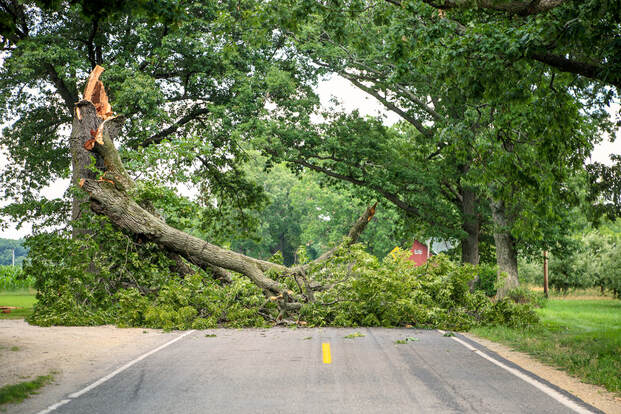|
A common reason to get rid of trees is that leaving them where they are is a danger and a liability. A common reason to get rid of trees is that leaving them where they are is a danger and a liability. As people who make a living taking down trees, we see a lot of dangerous trees. We remove them, and we see a lot of them as we’re out and about in the community.
It’s important to note that all trees are dangerous. Even a perfectly healthy tree can suddenly take a dive if, say, the ground gets saturated just in time for a bad wind storm. There’s no sense in becoming paranoid that a tree is suddenly going to fall on your car as you drive down the road, but as far as your own trees go, there are a few things to keep an eye on. 1. Rot. A rotten limb or trunk can break and fall on someone or something important. 2. Disease. Disease might seem like the same thing as rot, and, in effect, it is. It can cause limbs and trunks to fall. In addition, disease in one tree can lead to disease in neighboring trees, so its best to eradicate it as soon as possible. 3. Water weight. Some trees, like cottonwoods, absorb a lot of water when its available. The added weight makes trunks and limbs more likely to break. It also makes the falling debris more destructive. 4. Unreliable ground. Trees typically have a good sense of how well supported they are by the earth, and grow accordingly. But that doesn’t help if the soil is destabilized after the fact, by things like natural erosion, moisture or human activity. 5. Size. Obviously a 1’ thick, 15’ tall cottonwood is somewhat less a concern than an 8’ thick, 150’ tall Douglas fir.5. Proximity. A 20’ tall rotten cottonwood can be a problem if its right next to where you park your car, or where your kids play. If the same tree is out in an unused pasture, its less a threat to life, limb and property. 7. Snow weight. A tree that can usually bear its own weight, no sweat, can be dangerous under the weight of a healthy snowfall. What’s more, some trees grow brittle in cold weather, to the point where they break rather than bend. 8. Dryness. A different kind of threat that trees can pose is fire. In the dry season, foliage can act like tinder for wildfires. Branches can act as a “fire bridge”, giving the fire a path to follow from tree to tree. In some cases, solving the problem just takes removing a certain tree that’s in proximity to a heat source, like a hot exhaust or a chimney. In other cases, you might need to thin a stand of trees and remove underbrush to slow down a potential wildfire. 9. The type of tree. Certain types of trees just tend to be more dangerous. In a peculiar current case, the Western Hemlock has been highly susceptible to disease. This means you should take a good look at the state of any large Western Hemlocks on your property, and advise your neighbors to do the same. We’ve covered this problem in a previous post you can find here. Here are four trees common to the area that are particularly dangerous, and should have a close eye kept on them: Cottonwoods: These trees grow like weeds, and are common in wet areas like swamps and riverbanks. The wood is soft, and breaks easily. Add in the fact that they absorb water to the point of total saturation, which can lead to them breaking under the added weight. Maple. These deciduous trees have a large spreading canopy that takes up a lot of space overhead. The problem is that its perfectly normal for a big maple tree to have deadwood limbs in its canopy. These limbs should be pruned before they fall on somebody. Western Hemlock. Our state tree is experiencing a blight, currently. The insides of the tree are being eaten away, making them likely to fall. We’ve removed entire stands of Western hemlocks for this reason. If you have these trees on your property, we recommend keeping an eye on them. Learn more about their predicament here Alder. The alder is typically not a healthy tree. Expect them to be brittle and have dead rot. Although they are not particularly large trees, we recommend not having them close to your house. For estimates on tree removals, stump grinding and brush clearing in Snohomish and surrounding areas, you can click here to fill out an estimate form. |
SNOHOMISH TREE COMPANYFollow our blog for industry insights, company updates, and tips for working with trees. Archives
February 2022
Categories |


 RSS Feed
RSS Feed
